Page 68 of 273
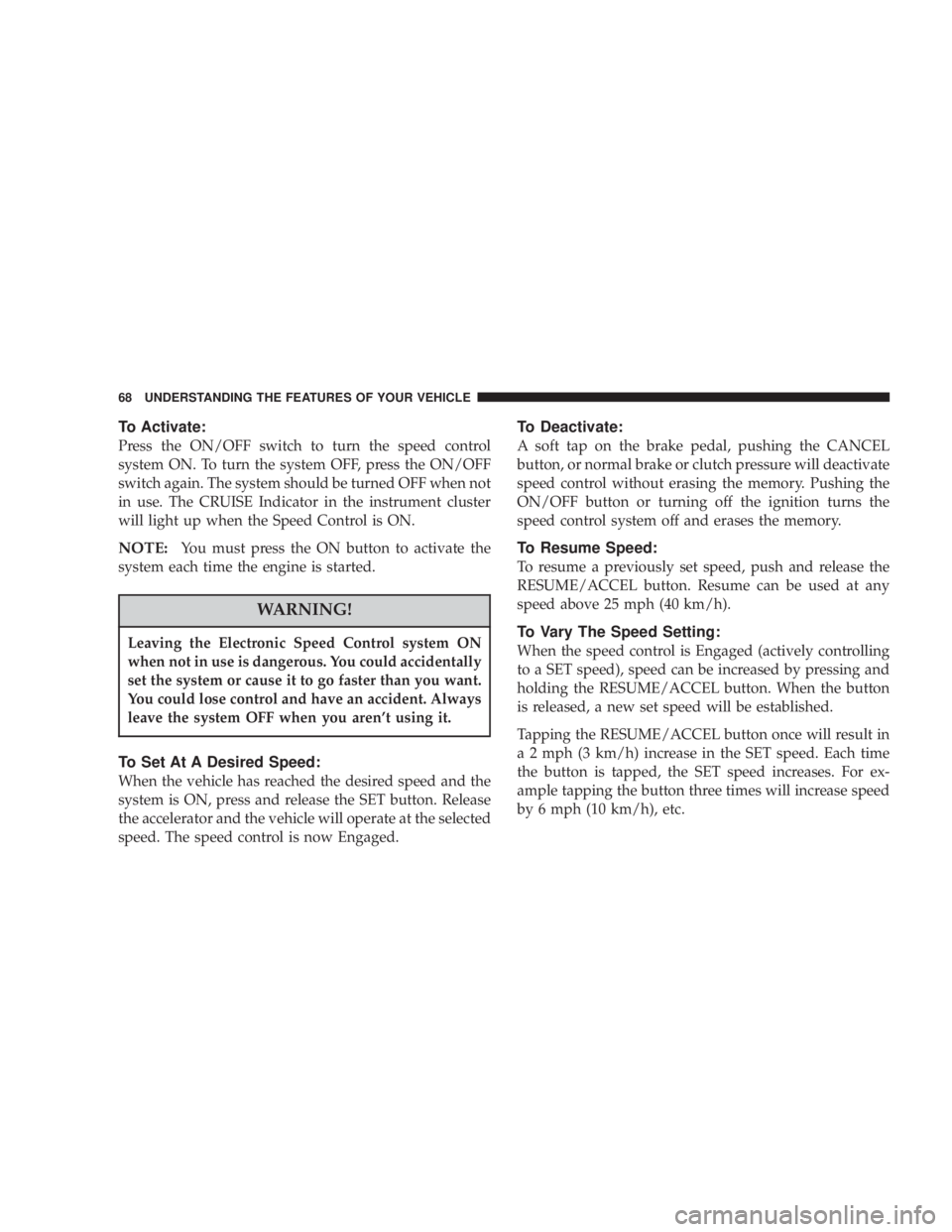
To Activate:
Press the ON/OFF switch to turn the speed control
system ON. To turn the system OFF, press the ON/OFF
switch again. The system should be turned OFF when not
in use. The CRUISE Indicator in the instrument cluster
will light up when the Speed Control is ON.
NOTE:You must press the ON button to activate the
system each time the engine is started.
WARNING!
Leaving the Electronic Speed Control system ON
when not in use is dangerous. You could accidentally
set the system or cause it to go faster than you want.
You could lose control and have an accident. Always
leave the system OFF when you aren't using it.
To Set At A Desired Speed:
When the vehicle has reached the desired speed and the
system is ON, press and release the SET button. Release
the accelerator and the vehicle will operate at the selected
speed. The speed control is now Engaged.
To Deactivate:
A soft tap on the brake pedal, pushing the CANCEL
button, or normal brake or clutch pressure will deactivate
speed control without erasing the memory. Pushing the
ON/OFF button or turning off the ignition turns the
speed control system off and erases the memory.
To Resume Speed:
To resume a previously set speed, push and release the
RESUME/ACCEL button. Resume can be used at any
speed above 25 mph (40 km/h).
To Vary The Speed Setting:
When the speed control is Engaged (actively controlling
to a SET speed), speed can be increased by pressing and
holding the RESUME/ACCEL button. When the button
is released, a new set speed will be established.
Tapping the RESUME/ACCEL button once will result in
a 2 mph (3 km/h) increase in the SET speed. Each time
the button is tapped, the SET speed increases. For ex-
ample tapping the button three times will increase speed
by 6 mph (10 km/h), etc.
68 UNDERSTANDING THE FEATURES OF YOUR VEHICLE
Page 85 of 273
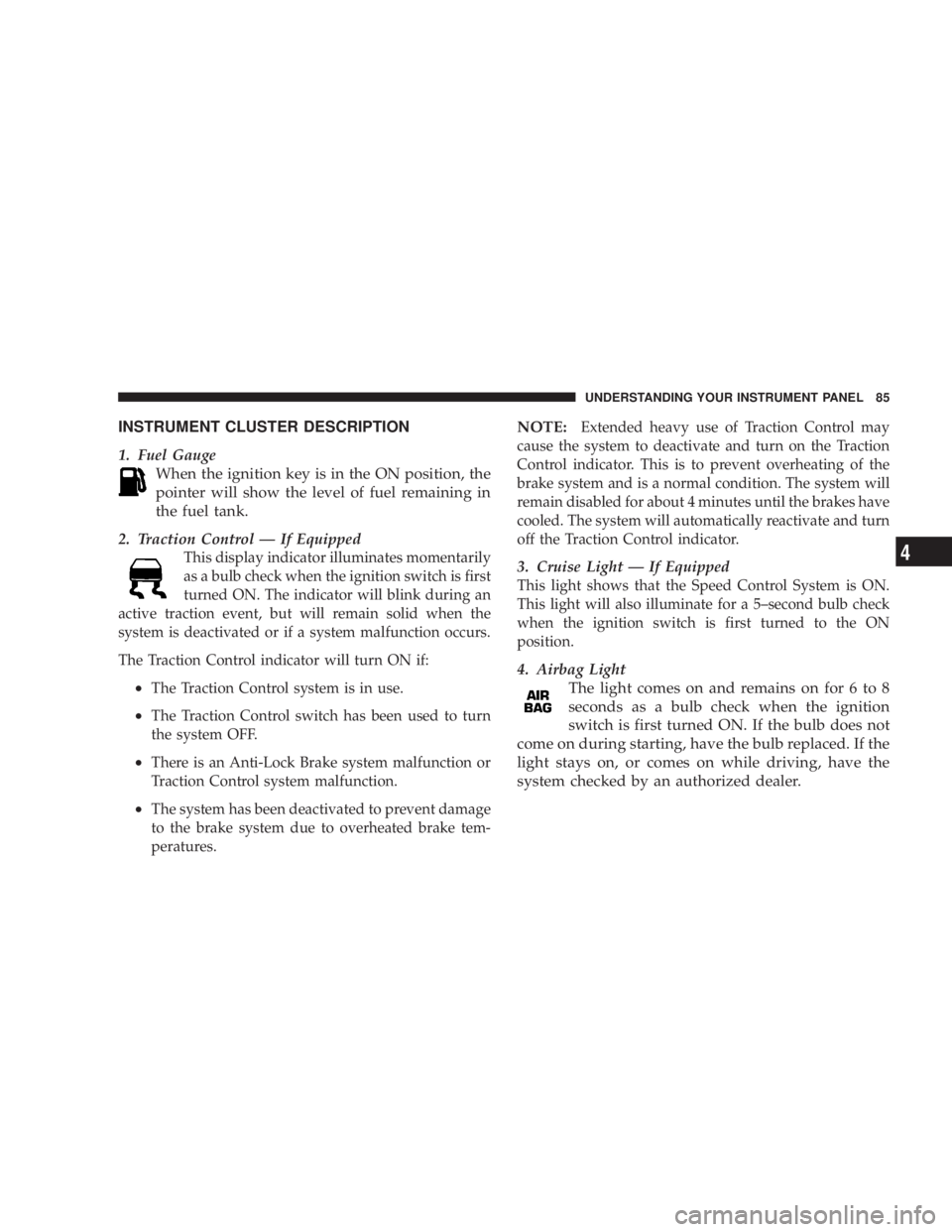
INSTRUMENT CLUSTER DESCRIPTION
1. Fuel Gauge
When the ignition key is in the ON position, the
pointer will show the level of fuel remaining in
the fuel tank.
2. Traction Control Ð If Equipped
This display indicator illuminates momentarily
as a bulb check when the ignition switch is first
turned ON. The indicator will blink during an
active traction event, but will remain solid when the
system is deactivated or if a system malfunction occurs.
The Traction Control indicator will turn ON if:
²The Traction Control system is in use.
²The Traction Control switch has been used to turn
the system OFF.
²There is an Anti-Lock Brake system malfunction or
Traction Control system malfunction.
²The system has been deactivated to prevent damage
to the brake system due to overheated brake tem-
peratures.
NOTE:Extended heavy use of Traction Control may
cause the system to deactivate and turn on the Traction
Control indicator. This is to prevent overheating of the
brake system and is a normal condition. The system will
remain disabled for about 4 minutes until the brakes have
cooled. The system will automatically reactivate and turn
off the Traction Control indicator.
3. Cruise Light Ð If Equipped
This light shows that the Speed Control System is ON.
This light will also illuminate for a 5±second bulb check
when the ignition switch is first turned to the ON
position.
4. Airbag Light
The light comes on and remains on for 6 to 8
seconds as a bulb check when the ignition
switch is first turned ON. If the bulb does not
come on during starting, have the bulb replaced. If the
light stays on, or comes on while driving, have the
system checked by an authorized dealer.
UNDERSTANDING YOUR INSTRUMENT PANEL 85
4
Page 127 of 273
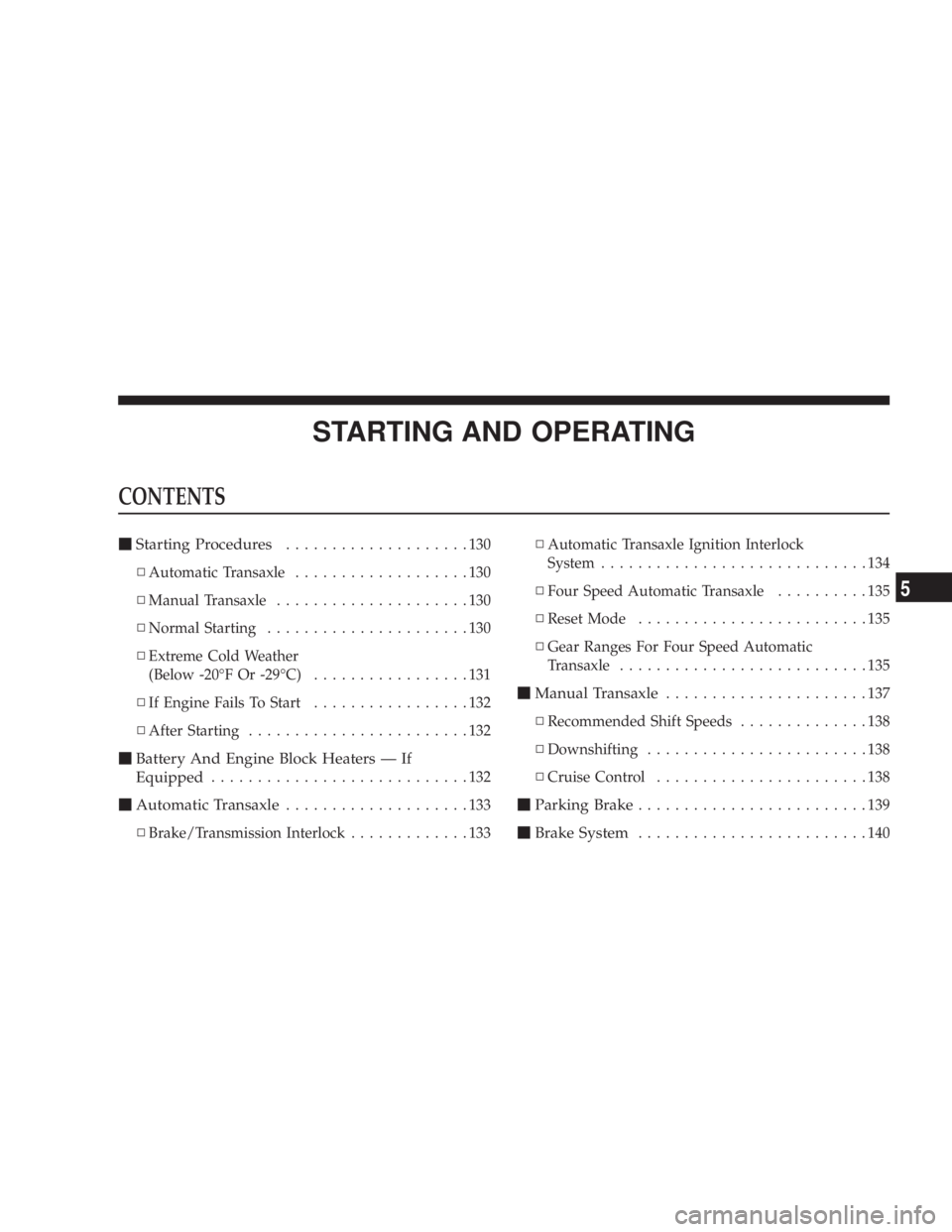
STARTING AND OPERATING
CONTENTS
mStarting Procedures....................130
NAutomatic Transaxle...................130
NManual Transaxle.....................130
NNormal Starting......................130
NExtreme Cold Weather
(Below -20ÉF Or -29ÉC).................131
NIf Engine Fails To Start.................132
NAfter Starting........................132
mBattery And Engine Block Heaters Ð If
Equipped
............................132
mAutomatic Transaxle....................133
NBrake/Transmission Interlock.............133NAutomatic Transaxle Ignition Interlock
System.............................134
NFour Speed Automatic Transaxle..........135
NReset Mode.........................135
NGear Ranges For Four Speed Automatic
Transaxle...........................135
mManual Transaxle......................137
NRecommended Shift Speeds..............138
NDownshifting........................138
NCruise Control.......................138
mParking Brake.........................139
mBrake System.........................140
5
Page 138 of 273
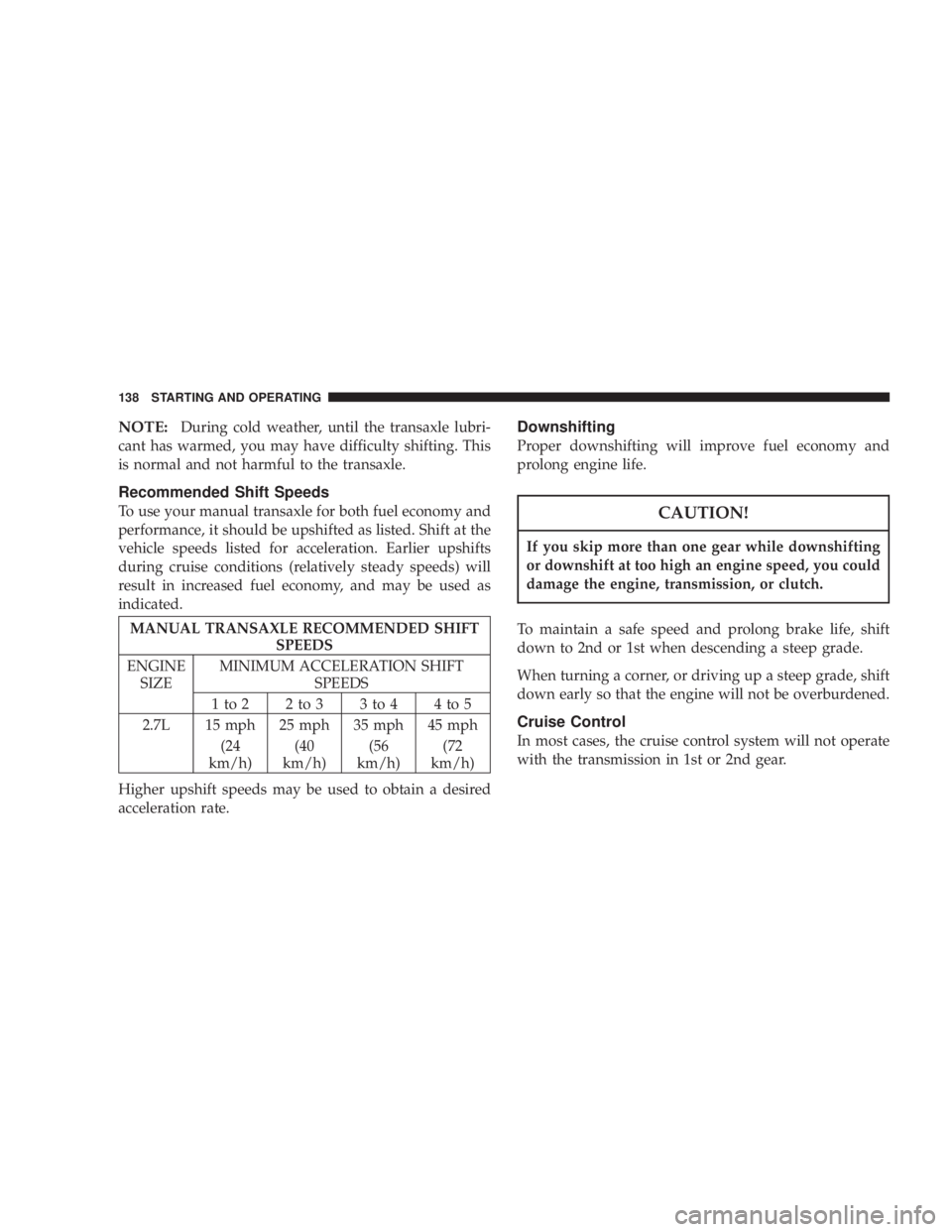
NOTE:During cold weather, until the transaxle lubri-
cant has warmed, you may have difficulty shifting. This
is normal and not harmful to the transaxle.
Recommended Shift Speeds
To use your manual transaxle for both fuel economy and
performance, it should be upshifted as listed. Shift at the
vehicle speeds listed for acceleration. Earlier upshifts
during cruise conditions (relatively steady speeds) will
result in increased fuel economy, and may be used as
indicated.
MANUAL TRANSAXLE RECOMMENDED SHIFT
SPEEDS
ENGINE
SIZEMINIMUM ACCELERATION SHIFT
SPEEDS
1to2 2to3 3to4 4to5
2.7L 15 mph 25 mph 35 mph 45 mph
(24
km/h)(40
km/h)(56
km/h)(72
km/h)
Higher upshift speeds may be used to obtain a desired
acceleration rate.
Downshifting
Proper downshifting will improve fuel economy and
prolong engine life.
CAUTION!
If you skip more than one gear while downshifting
or downshift at too high an engine speed, you could
damage the engine, transmission, or clutch.
To maintain a safe speed and prolong brake life, shift
down to 2nd or 1st when descending a steep grade.
When turning a corner, or driving up a steep grade, shift
down early so that the engine will not be overburdened.
Cruise Control
In most cases, the cruise control system will not operate
with the transmission in 1st or 2nd gear.
138 STARTING AND OPERATING
Page 264 of 273
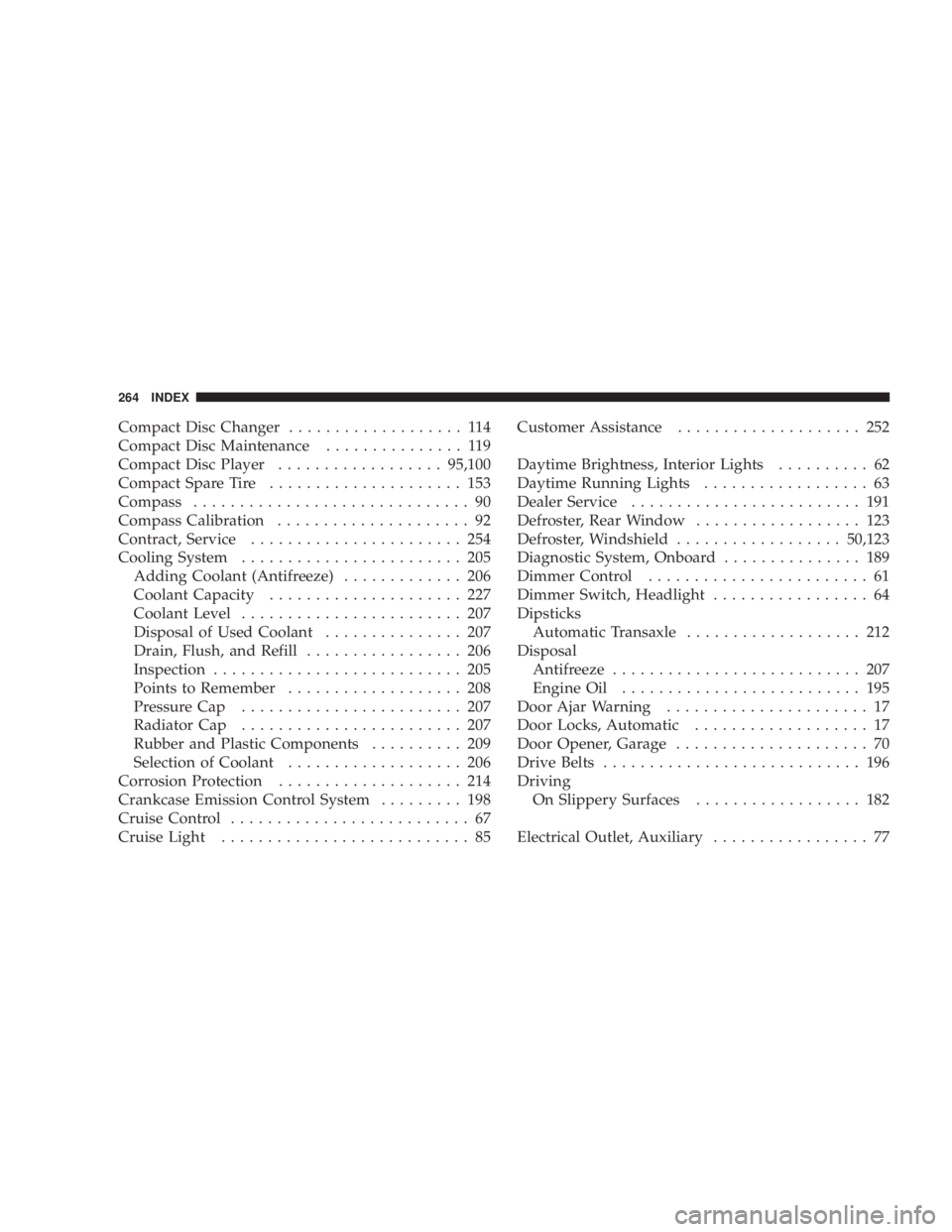
Compact Disc Changer................... 114
Compact Disc Maintenance............... 119
Compact Disc Player..................95,100
Compact Spare Tire..................... 153
Compass.............................. 90
Compass Calibration..................... 92
Contract, Service....................... 254
Cooling System........................ 205
Adding Coolant (Antifreeze)............. 206
Coolant Capacity..................... 227
Coolant Level........................ 207
Disposal of Used Coolant............... 207
Drain, Flush, and Refill................. 206
Inspection........................... 205
Points to Remember................... 208
Pressure Cap........................ 207
Radiator Cap........................ 207
Rubber and Plastic Components.......... 209
Selection of Coolant................... 206
Corrosion Protection.................... 214
Crankcase Emission Control System......... 198
Cruise Control.......................... 67
Cruise Light........................... 85Customer Assistance.................... 252
Daytime Brightness, Interior Lights.......... 62
Daytime Running Lights.................. 63
Dealer Service......................... 191
Defroster, Rear Window.................. 123
Defroster, Windshield..................50,123
Diagnostic System, Onboard............... 189
Dimmer Control........................ 61
Dimmer Switch, Headlight................. 64
Dipsticks
Automatic Transaxle................... 212
Disposal
Antifreeze........................... 207
Engine Oil.......................... 195
Door Ajar Warning...................... 17
Door Locks, Automatic................... 17
Door Opener, Garage..................... 70
Drive Belts............................ 196
Driving
On Slippery Surfaces.................. 182
Electrical Outlet, Auxiliary................. 77
264 INDEX